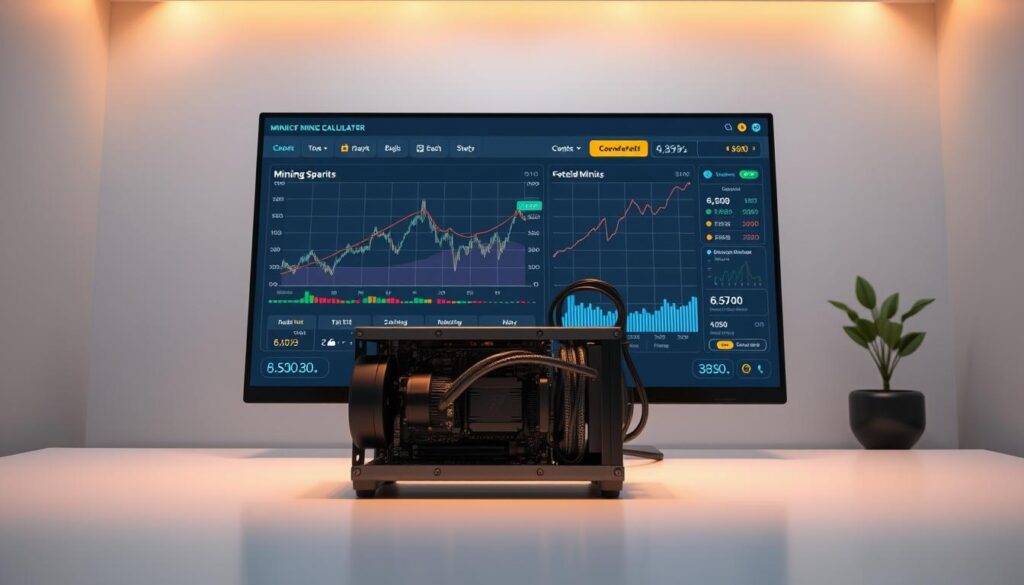Now Reading: Crypto Mining Profitability Calculator All GPUs 2026 Comparison
- 01
Crypto Mining Profitability Calculator All GPUs 2026 Comparison
Crypto Mining Profitability Calculator All GPUs 2026 Comparison
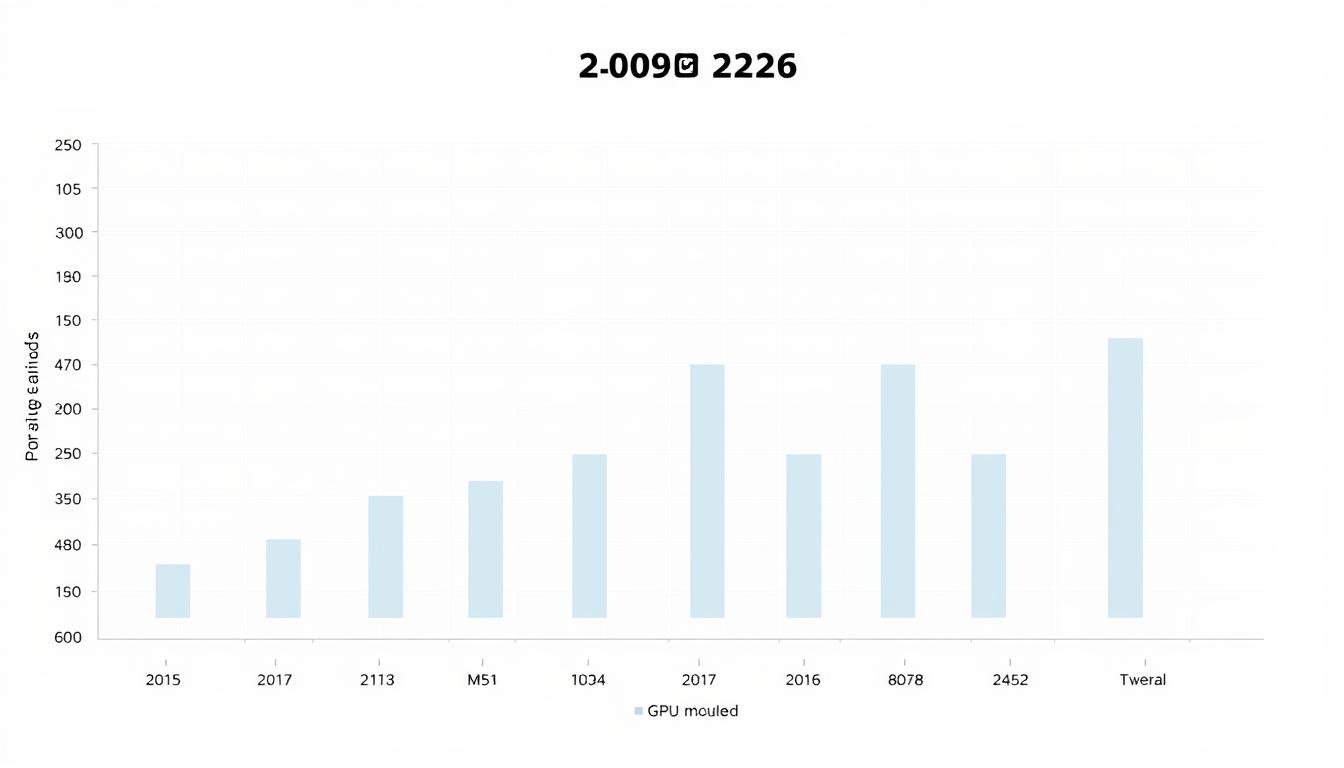
Choosing the right hardware is a critical first step for anyone building a digital currency generation setup. This guide provides a detailed look at graphics processing units to help you make an informed choice.
Our analysis uses data from Hashrate.no and other sources to evaluate over 60 different models. This includes older cards like the GTX 1050 and the newest releases such as the RTX 5090. Please note: Hashrate.no uses affiliate links and tracks user inputs. We make no warranties about data accuracy. Users assume all risks for their decisions. All data is © Lineo AS 2021-2025.
Understanding potential earnings involves more than just raw speed. You must also consider power draw, your local electricity rates, and the current market value of digital assets. These factors directly influence your daily bottom line.
This side-by-side evaluation covers both Nvidia and AMD product families. It examines performance on specific tasks, memory specs, and heat output. The goal is to give a complete financial picture, from initial cost to long-term operating expenses.
Key Takeaways
- Evaluating hardware requires looking at performance, power use, and electricity costs together.
- Data from real-world operations provides practical insights beyond theoretical numbers.
- The analysis includes a wide range of models from both major manufacturers.
- Total cost of ownership, including purchase price and energy bills, is a key factor.
- This information helps both new and experienced builders optimize their setups for better returns.
- Always verify data from multiple sources, as market conditions change rapidly.
Introduction to GPU Crypto Mining Profitability
Before committing to any hardware purchase, assessing potential earnings is essential for long-term success. This evaluation forms the core of intelligent investment decisions in digital asset generation.
Purpose and Scope
Thorough financial analysis goes beyond simple revenue estimates. It includes break-even timelines and return on investment projections across different hardware models.
The scope covers multiple computational approaches like KawPow and Equihash. Different digital currencies require specific architectures for optimal performance.
Importance of Profitability Calculations
Accurate assessments prevent costly errors by identifying equipment that operates at a loss. This helps avoid purchases that cannot sustain positive financial outcomes.
These calculations must consider dynamic market factors. Price changes and network adjustments significantly impact operational results over time.
Understanding this importance helps optimize operations by switching between approaches based on real-time profit potential. This framework treats digital asset generation as a business decision rather than speculation.
Understanding the “crypto mining profitability calculator all GPUs 2026 comparison”
A detailed financial analysis tool is indispensable for navigating the complexities of hardware selection. This platform provides a clear framework for evaluating potential returns.
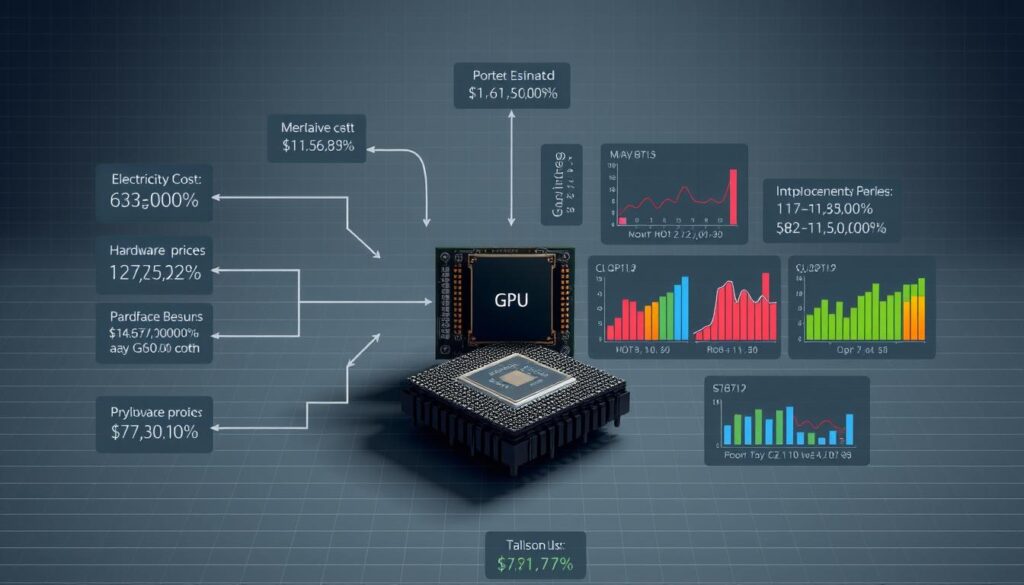
How the Calculator Works
The system operates by gathering live data from several sources. It processes hashrate performance and current digital asset values.
This data is combined with your specific electricity costs. The result is a net daily profit estimate for each graphics card.
Customization is a key feature. You can adjust power rates to match your local utility bills. This transforms general data into a personalized financial outlook.
Data Sources and Reliability
Information comes from established platforms like Hashrate.no and Hiveon. These sources provide real-world performance metrics from active operations.
However, these figures are snapshots in time. Market values and network conditions change rapidly.
The platform offers no guarantees about data accuracy. Users must perform their own due diligence. All investment risks are borne by the individual.
Key Factors Affecting Mining Profitability
Several crucial elements determine whether your hardware generates positive financial results. Understanding these variables helps you maximize your return on investment.
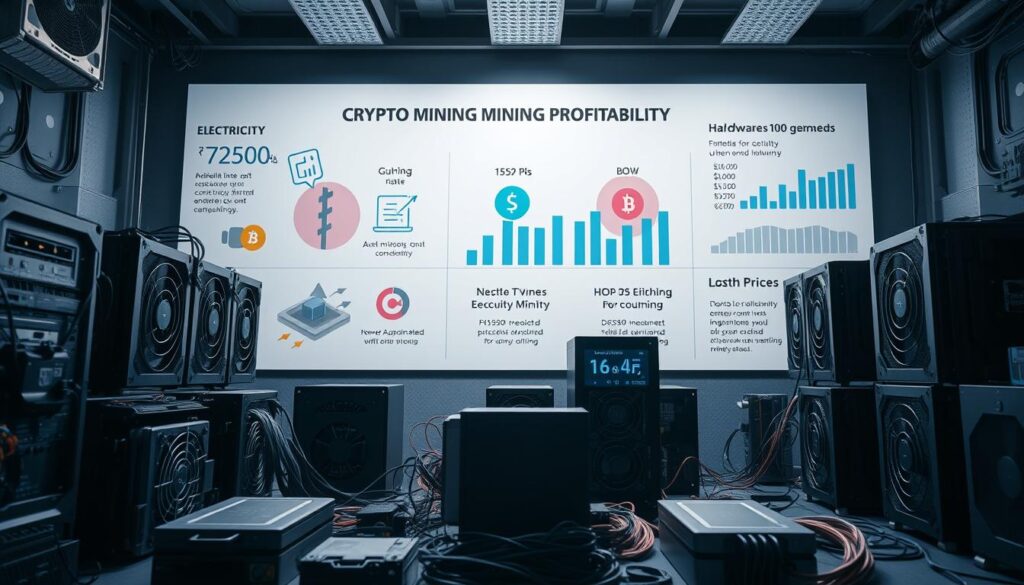
Hashrate and Efficiency
Hashrate measures your card’s speed at solving complex puzzles. A higher rate means more potential earnings before costs.
Efficiency is the real key to profit. It’s calculated by dividing hashrate by power draw. Cards with better efficiency ratios earn more per dollar spent on electricity.
Newer architectures often provide superior performance per watt. Some older models face issues like memory throttling, which can drastically reduce effective output.
Power Consumption and Cost Considerations
Your electricity rate is a major factor in your final profit. A card using 300 watts at $0.10 per kWh costs $0.72 daily to run.
Optimization techniques can significantly reduce power use. Settings like undervolting or limiting TDP can cut consumption by 20-40%. This improves margins without hardware changes.
Always match your card’s strengths to the most suitable digital assets. This ensures you get the best possible return from your setup.
High-End GPU Models: Benchmarking & Analysis
High-performance graphics cards represent the pinnacle of hardware for digital asset generation. These premium models deliver superior computational power for complex algorithms.
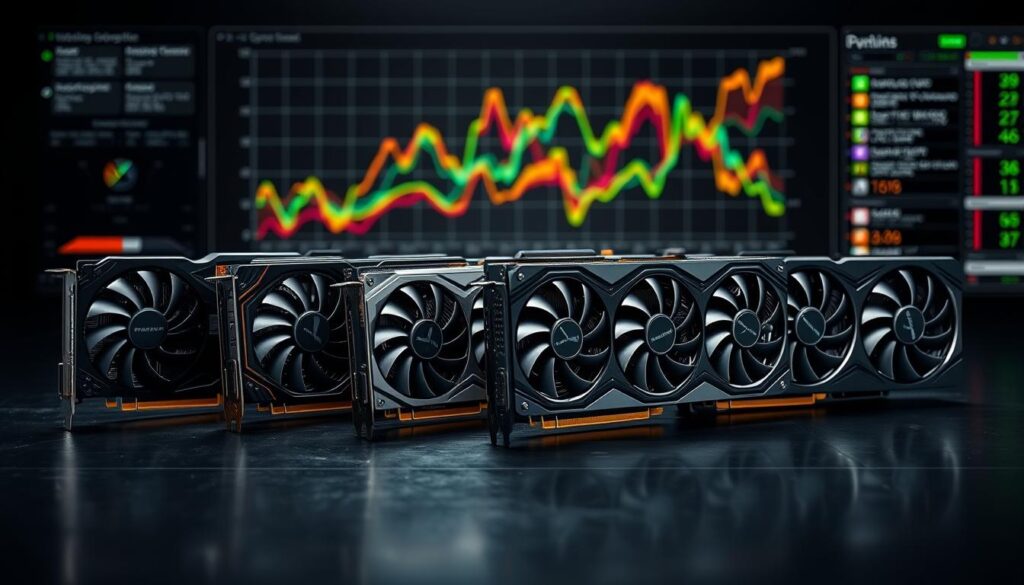
The Nvidia RTX 4090 currently leads performance rankings. It generates approximately $0.36 daily profit on Ravencoin using KawPow. This results from $1.15 revenue against $0.79 operational costs.
Nvidia RTX 4090, 4080, and 4070 Series
These flagship models demonstrate remarkable efficiency when properly configured. The rtx 4080 variants offer balanced performance at lower price points. They maintain strong profit margins across multiple algorithms.
Optimization is crucial for maximizing returns. Setting TDP between 60-80% significantly reduces power consumption. This preserves hashrate while improving electrical efficiency.
Performance Metrics from Web Sources
Real-world data from platforms like Mining Rig Rentals confirms consistent performance. The RTX 4070 generates about $0.20 daily profit on ProgPowZ. It consumes only 175 watts at optimized settings.
Algorithm selection directly impacts financial outcomes. KawPow and ProgPowZ typically yield positive returns. Memory-intensive approaches may produce lower profit or losses.
These high-end cards avoid the memory throttling issues found in previous generations. This ensures reliable operation and steady earnings. The substantial initial investment requires careful break-even calculation.
Mid-Range and Budget GPU Options
Entry-level graphics processing units provide accessible starting points for newcomers to computational asset generation. These affordable cards offer practical testing grounds without requiring substantial financial commitments.

Budget hardware selections balance initial costs against potential returns. Careful optimization can maximize efficiency even with older equipment.
Nvidia GTX Series and AMD Equivalents
The gtx 1660 series demonstrates modest daily profit around $0.04 on Equihash algorithms. Proper configuration with +100/+500 clock adjustments at 65-70% TDP improves electrical efficiency.
Legacy models like the gtx 1080 and gtx 1070 maintain relevance through optimization. These cards require specific settings to achieve positive financial outcomes.
| GPU Model | Daily Profit | Optimization Settings | Best Algorithm |
|---|---|---|---|
| GTX 1660 | $0.04 | +100/+500, 70% TDP | Equihash |
| GTX 1080 | $0.08 | +125/+500, 70% TDP | KawPow |
| GTX 1070 | $0.06 | +150/+500, 75% TDP | ProgPowZ |
| RTX 3050 | $0.03 | +100/+400, 65% TDP | Ethash |
| GTX 1050 | $0.01 | +150/+500, 75% TDP | Light algorithms |
The rtx 3050 represents newer budget options with similar profit margins. Meanwhile, the gtx 1050 struggles to generate meaningful returns in current market conditions.
AMD equivalents like RX 580 and RX 6600 compete effectively in this category. They often provide better memory performance for specific computational approaches.
Comparing Popular Models: Performance vs. Profit
Direct comparison of popular graphics cards reveals significant differences in financial returns across different performance tiers. Understanding these variations helps investors make smarter hardware choices.
Daily Profit Estimates and Cost Analysis
The RTX 3080 Ti demonstrates strong financial performance with $0.26 daily profit on ProgPowZ. This results from $0.92 revenue against $0.67 operational costs.
Meanwhile, the RTX 3090 generates $0.23 daily profit despite higher power consumption. Its $0.77 electricity costs offset superior computational speed.
Mid-range options like the RTX 3070 and RTX 3060 Ti both achieve $0.19 daily profit. Their lower power requirements create excellent efficiency ratios.
Case Studies from Industry Data
Real-world data from Mining Rig Rentals shows consistent patterns across models. The RTX 4070 delivers $0.20 daily profit with balanced power draw.
Entry-level RTX 3060 variants maintain positive returns at $0.12 daily. This positions them as accessible options for newcomers.
| GPU Model | Daily Profit | Revenue | Electricity Cost |
|---|---|---|---|
| RTX 3080 Ti | $0.26 | $0.92 | $0.67 |
| RTX 3090 | $0.23 | $1.00 | $0.77 |
| RTX 3080 LHR | $0.22 | $0.83 | $0.60 |
| RTX 4070 | $0.20 | $0.70 | $0.50 |
| RTX 3060 Ti LHR | $0.19 | $0.51 | $0.32 |
Algorithm selection proves critical for maximizing returns. ProgPowZ consistently delivers better results than alternative approaches.
Real-World Results and Insights
Real operational metrics from active systems offer a more accurate picture of long-term hardware viability. These practical results often differ significantly from theoretical benchmarks.
Profit Data from Mining Rig Rentals
The rtx 2080 Ti demonstrates modest but consistent performance in real-world operations. It generates approximately $0.17 daily profit on ProgPowZ algorithms.
However, the same card shows negative returns on the octopus algorithm. This highlights how architectural limitations impact financial outcomes.
Standard rtx 2080 models produce around $0.07 daily earnings. The Super variant achieves slightly better profit margins at $0.08.
Observations on Memory Throttling & Efficiency
The rtx 3090 and rtx 3080 series face significant thermal challenges. Memory throttling reduces effective performance on memory-intensive workloads.
Proper optimization is essential for maintaining consistent profit. Settings like +100/+0 at 80-90% TDP help manage thermal limitations.
The rtx 3080 requires specific adjustments for different algorithms. These tuning strategies prevent performance degradation during extended operations.
Trends and Technological Advances in 2026
Recent hardware developments demonstrate that maximum computational power doesn’t always translate to optimal financial returns. The RTX 5000-series architecture shows this principle clearly across its product range.
Early data reveals surprising patterns. The flagship RTX 5090 actually shows negative daily returns despite generating the highest gross revenue. Its massive power consumption creates costs that exceed earnings.
Emerging GPU Efficiency Improvements
Mid-range models like the rtx 5070 demonstrate more promising results. They generate approximately $0.06 daily profit while consuming significantly less energy than previous-generation flagships.
The rtx 5060 variants target budget-conscious operators with lower power profiles. These cards maintain positive margins around $0.05 daily, making them viable for home operations with moderate electricity rates.
Architectural advances focus on performance-per-watt gains rather than raw speed increases. This shift benefits long-term sustainability. Cards like the rtx 5070 deliver competitive results while outperforming older models like the rtx 4080 in efficiency metrics.
These trends highlight that newest technology doesn’t automatically mean best profit. Careful analysis of power consumption against potential earnings remains essential for successful hardware selection.
Using the Calculator for Informed Decision-Making
Modern computational analysis platforms provide the framework needed to make data-driven hardware purchasing decisions. These tools transform technical specifications into clear financial projections.
Step-by-Step Guide to Evaluating GPUs
Begin by entering your exact electricity costs. Even small differences can dramatically impact your final profit margins. Compare the rtx 4060 against the rtx 3060 to identify the best value proposition.
Algorithm selection proves critical for maximizing returns. The rtx 4060 generates solid profit on Equihash but shows negative results on other approaches. The rtx 3070 maintains consistent earnings across multiple workloads.
Optimization Tips for Better Results
Configure TDP limits between 60-80% for rtx 4070 and rtx 4060 models. This reduces power consumption while preserving competitive performance. Memory adjustments can further boost your daily profit.
The rtx 3060 requires careful break-even analysis due to its modest earnings potential. Consider specialized hardware alternatives for operations requiring maximum efficiency. Always model different market scenarios to identify which equipment maintains positive profit across changing conditions.
Additional Considerations for Crypto Miners
Advanced configuration techniques separate amateur operations from professional digital asset generation setups. Proper hardware tuning can significantly impact your operational efficiency and financial outcomes.
Fine-tuning your equipment requires understanding both performance gains and potential risks. This involves careful adjustments to clock speeds, voltage settings, and thermal management.
Overclocking, Voltage Adjustments, and Safety
The rtx 2060 benefits from conservative +100 core and +200 memory adjustments at 70% TDP. This modest approach can increase daily profit from $0.05 to around $0.06-0.07 without excessive risk.
For the rtx 2070, algorithm selection proves critical. It generates $0.03 daily profit on ProgPowZ but shows negative results on the octopus algorithm. Voltage adjustments at +100/+200 with 75% TDP balance performance against power consumption.
Memory-intensive approaches like octopus benefit from memory overclocking on Turing-generation cards. However, the rtx 2060 and rtx 2070 may experience diminished profit margins on this algorithm compared to compute-focused alternatives.
Safety remains paramount when pushing hardware limits. Aggressive settings can cause system instability or hardware damage. Always test configurations incrementally and monitor temperatures continuously.
| GPU Model | Optimization Settings | Best Algorithm | Daily Profit |
|---|---|---|---|
| RTX 2060 | +100/+200, 70% TDP | ProgPowZ | $0.05 |
| RTX 2070 | +100/+200, 75% TDP | ProgPowZ | $0.03 |
| RTX 2080 | +100/+200, 80% TDP | ProgPowZ | $0.17 |
| GTX 1660 | +100/+500, 65% TDP | Equihash | $0.04 |
| GTX 1080 | +125/+500, 75% TDP | KawPow | $0.08 |
Legacy cards like the gtx 1070 require more aggressive settings to remain competitive. The rtx 2080 responds well to standard adjustments but prioritize stability over maximum performance. Conservative 5-10% gains typically prove safer than aggressive 20-30% overclocks.
Conclusion
The landscape of computational asset generation continues to evolve with efficiency becoming paramount. Our analysis reveals that operations remain viable for specific hardware configurations when properly optimized.
High-performance cards like the RTX 4090 demonstrate strong earning potential. Meanwhile, balanced options such as the rtx 4060 maintain positive daily returns. This makes them accessible choices for various operational scales.
Successful outcomes depend on thorough analysis beyond raw performance metrics. Electricity costs, algorithm selection, and proper configuration significantly impact final profit margins. These factors often determine whether operations generate sustainable returns.
The evaluation tool provides essential insights for informed decision-making. It helps identify equipment that delivers consistent profit under current market conditions. This prevents costly mistakes and maximizes operational efficiency.
Ultimately, sustainable profit requires balancing hardware capabilities with real-world operational costs. Careful planning and continuous optimization remain key to long-term success in this dynamic field.
FAQ
How accurate are the projected earnings for 2026?
The projections are based on current market data, hardware specifications, and anticipated trends. They provide a strong estimate, but actual earnings can fluctuate due to changes in network difficulty and coin value.
Which graphics card offers the best return on investment for Ethereum mining?
Based on current data, the Nvidia RTX 4090 often leads in raw performance. However, models like the RTX 4070 or RTX 3080 can provide a better balance of upfront cost and long-term efficiency for many setups.
Why is power consumption a critical factor in my calculations?
Electricity costs directly eat into your net gains. A high-performing card with excessive power draw can be less profitable than a moderately efficient one, especially in regions with high energy prices.
What is the impact of memory throttling on my daily profit?
Memory throttling, common in cards like the RTX 3070, reduces hashrate and efficiency. Proper cooling and potential hardware modifications are essential to maintain stable, profitable operation.
Should I consider older models like the GTX 1660 or RTX 2060 in 2026?
Older GPUs can be viable for specific algorithms or as entry-level options if acquired at a low cost. Their lower efficiency often makes them less competitive against newer generations for primary operations.
How do I use the calculator to compare an RTX 4080 versus an RTX 5070?
Input each card’s hashrate, power draw, and your local electricity rate. The tool will compute estimated daily and monthly net profit, helping you evaluate which model suits your budget and goals.
Are the results for algorithms like Octopus reliable?
Yes, the data for various algorithms, including Octopus, is sourced from real-world benchmarks and community-reported figures. This ensures practical insights for miners diversifying their operations.
What optimization tips can improve my rig’s results?
Key strategies include fine-tuning core and memory clock speeds, undervolting to reduce power consumption, and ensuring excellent airflow to prevent thermal throttling for consistent performance.


